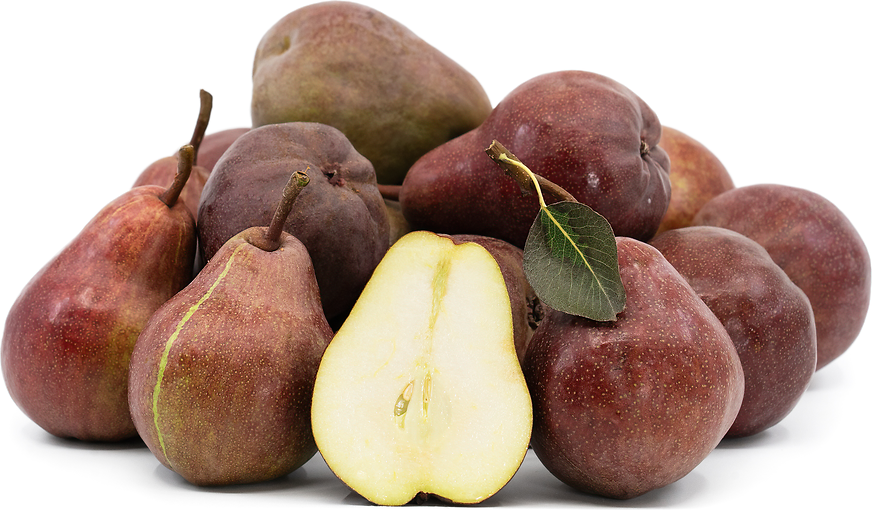


Red Bartlett Pears
Estimated Inventory, 18 lbs : 0
This item was last sold on : 05/01/25
Description/Taste
Red Bartlett pears are medium to large in size and are the only pears that have a true pyriform, or pear shape, which is rounded on a large bottom half that tapers to a smaller curved neck with a light brown-red, slender stem. The skin changes as it ripens, transforming from dark maroon to a bright red, and the surface is smooth, firm, and thick with some blushing, vertical striping, and yellow speckling. The flesh is aromatic, moist, off-white to ivory, and is fine-grained encasing a central core containing a few small, black-brown seeds. When mature but not fully ripe, Red Bartlett pears are crunchy and tart, but when fully ripe, they develop a juicy, buttery texture with a sweet flavor.
Seasons/Availability
Red Bartlett pears are available year-round, with peak season in the fall through winter.
Current Facts
Red Bartlett pears, botanically classified as Pyrus communis, are the fruits of a fast-growing tree that can reach over six meters in height and are members of the Rosaceae family along with apples, peaches, and apricots. Also known as Max Reds, Red Bartlett pears are often called summer pears because they are the first variety of pear to be harvested in the late summer. Red Bartlett pears are favored for their deep coloring, sweet flavor, and smooth texture, and can be used in a wide variety of culinary applications including savory dishes, desserts, and cocktails.
Nutritional Value
Red Bartlett pears contain potassium, fiber, vitamin C, and some iron.
Applications
Red Bartlett pears are best suited for raw and cooked applications such as boiling, baking, and sautéing. They can be added to salads as a pop of color and sweet flavor, sliced and displayed on cheese plates, layered in sandwiches, sprinkled on top of flatbreads, or served fresh, out-of-hand. Red Bartlett pears are also used to make crisps, cakes, molasses cookies, muffins, butter, syrups, and preserves, or they can be incorporated into pasta, salsas, rice, and slaws. In addition to culinary dishes, Red Bartlett pears can be used in specialty cocktails such as mojitos or shrubs with vanilla and cardamom. Red Bartlett pears compliment cucumber, corn, meats such as salami, ham, lamb, pork, beef, and poultry, pickled red peppers, baby arugula, pasta, black rice, pine nuts, walnuts, oregano, mint, cilantro, garlic, onion, Greek yogurt, tahini, black cherries, gouda, and halloumi cheese. They will keep up to three weeks when stored in the refrigerator and a little over one year when stored in the freezer.
Ethnic/Cultural Info
Red Bartlett pears have the same texture and taste as the green-yellow bartlett; the only difference is the skin color. Red Bartlett pears can be used interchangeably with yellow bartlett pears in recipes, and they are often used as a vibrant décor piece. They are used in holiday baskets or are paired with yellow bartlett pears and displayed in fruit bowls as table centerpieces.
Geography/History
Red Bartlett pears were discovered as a bud sport on a common bartlett tree in Washington State in 1938. Bud sports are a natural occurrence and often appear on fruit trees but typically go unnoticed as not all bud sports produce viable fruit. This particular bud sport was just as sweet and flavorful as the yellow bartlett and was chosen for cultivation. Today more than half of the Red Bartlett pears in the United States are grown in California where they thrive in the rich soil and moderate climate. They are also found at farmers markets and specialty grocers in Europe and Canada.
Recipe Ideas
Recipes that include Red Bartlett Pears. One
Podcasts

















